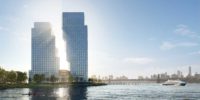Known for its outlandish architecture and oversized projects, Dubai is about to get its biggest development yet with a new 34,435-acre urban district slated to house as many as 1.5 million people. Rem Koolhaas’s Rotterdam-based Office for Metropolitan Architecture (OMA) is creating the master plan for Waterfront City, a site on the western edge of Dubai that could become as big and as dense as Manhattan.



Images © Office for Metropolitan Architecture
A rendering of Waterfront City in Dubai showing OMA’s own signature, spherical building (top). An artificial, square-shaped island will be created by flooding parts of a coastal area; development will occur on the island and in four waterfront districts that face it (middle). Waterfront City is located at the western edge of Dubai (above).
Dubai-based developer Nakheel commissioned OMA in early 2007. The master plan centers on an artificial, square-shaped island with a five-by-five grid of streets and a gross floor area of roughly 75 million square feet. On the mainland surrounding it will be four more urban districts totaling 130 million square feet. “Previous versions of the plan called for a radial pattern towards a center with a high rise, but the real estate got less valuable as it got further away from the water,” says Reinier de Graaf, a partner at OMA. “Having a vast waterfront spreads the real estate value across the site.” The project is still in the design phase, he adds, and it is too early to say when it will break ground.
The island will be created by drawing water from the Persian Gulf and channeling it into a series of canals. This flooding will take place in stages, allowing for construction on the buildings to take place at the same time. The Dutch firm WL | Delft Hydraulics is supervising this aspect of the project. “The Netherlands exists because of a fight against water, so there are many Dutch engineering firms,” de Graaf explains.
The plan also calls for five iconic buildings, including one designed by OMA: a spherical structure, whose diameter is 590 feet, that will house a convention center, residences, hotel rooms, retail, and other uses. “The only thing it will lack is a reason to leave,” de Graaf muses. Although the steel-and-concrete building is designed to be iconic and “eye catching” with its circular shape, he adds, it will be located on the edge of the island rather than the center. “Our goal is for the building to attract attention through its design cleverness, rather than by its size.”
OMA’s master plan will include aesthetic guidelines for the city’s other buildings, to be designed by other architects. “The philosophy is to control the look and the appearance of the building without restricting the other architects too much,” de Graaf says, although he was unable to discuss specifics at this time.
The master plan also addresses sustainability. To limit carbon emissions, buildings will be sited close together on tree-lined streets to encourage people to walk rather than drive; moreover, the tall, dense buildings will create natural shading that reduces the need for artificial air conditioning. A public transportation system will connect the island and surrounding areas. Waterfront City will also have a direct rail link to the Al Maktoum International Airport, currently under construction and set to become Dubai’s main hub.



